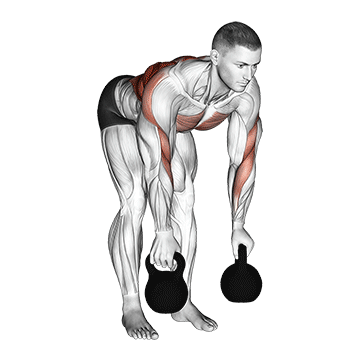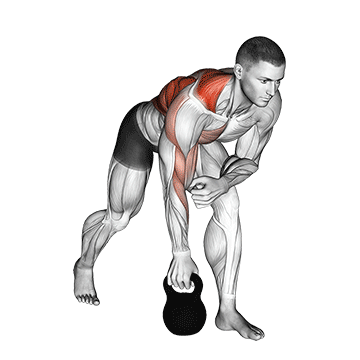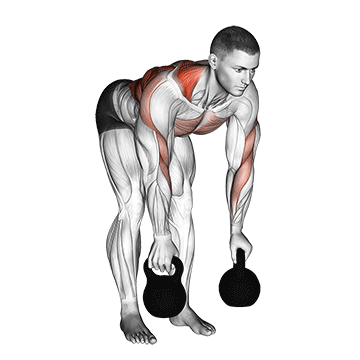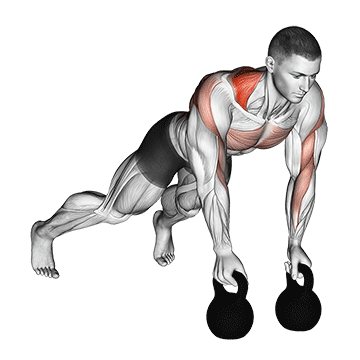Training your upper back is a crucial part of growing and sculpting your back. Whether you are a seasoned workout veteran or starting your first training plan, the workouts below will help you meet your fitness goals.
kettlebell two arm row

1. Start by standing upright with your feet shoulder-width apart. Hold a kettlebell in each hand with your palms facing each other.
2. Bend your knees slightly and hinge forward at your hips, keeping your back straight. Your torso should be almost parallel to the floor.
3. Let the kettlebells hang at arm's length directly below your shoulders. This is your starting position.
4. Pull the kettlebells towards your rib cage by bending your elbows and squeezing your shoulder blades together. Keep your elbows close to your body and do not let them flare out to the sides.
5. Pause for a moment at the top of the movement, then slowly lower the kettlebells back to the starting position.
6. Repeat this movement for the desired number of repetitions.
Remember to keep your core engaged and your back straight throughout the exercise. Avoid rounding your back or using your lower back to lift the weights. The power should come from your upper back and arms.
kettlebell one arm row

1. Start by placing the kettlebell on the floor in front of you. Stand with your feet hip-width apart, slightly bend your knees and lean forward from your hips.
2. Pick up the kettlebell with your right hand. Keep your left hand on your left knee for support. Make sure your back is straight and parallel to the floor. This is your starting position.
3. Pull the kettlebell up to your side, keeping your elbow close to your body. Ensure that you are pulling with your back muscles and not just your arm.
4. Hold the position for a second when the kettlebell is at the highest point, then slowly lower it back down to the starting position.
5. Repeat the movement for your desired number of repetitions.
6. Once you have completed the set, switch to your left hand and repeat the exercise.
Remember to keep your core engaged throughout the exercise to maintain balance and stability. Also, avoid rounding your back or using your shoulders to lift the kettlebell. The power should come from your upper back and arm.
kettlebell alternating row

1. Start by standing tall with your feet hip-width apart. Hold a kettlebell in each hand with your palms facing each other.
2. Bend your knees slightly and hinge forward at the hips, keeping your back straight. Your torso should be almost parallel to the floor.
3. Extend your arms directly below your shoulders, keeping the kettlebells off the ground. This is your starting position.
4. Pull the kettlebell in your right hand up to your chest, keeping your elbow close to your body. Your elbow should go past your back as you pull the kettlebell up.
5. Lower the kettlebell in your right hand back to the starting position.
6. Repeat the movement with the kettlebell in your left hand. This completes one rep.
7. Continue alternating between your right and left hand for the desired number of reps.
Remember to keep your core engaged and your back straight throughout the exercise. Avoid rounding your back or lifting your torso up as you row the kettlebells. The power should come from your upper back and arms, not your lower back.
kettlebell alternating renegade row

1. Start by placing two kettlebells on the floor about shoulder-width apart. Stand over the kettlebells with your feet hip-width apart.
2. Bend at your hips and knees, and grasp the kettlebell handles. Your palms should be facing each other.
3. Brace your abs and pull one kettlebell to your side, keeping your elbow close to your body. Lower the kettlebell back to the floor, maintaining control throughout the movement.
4. Repeat the row with your other arm. This is one rep.
5. Keep your hips and shoulders square to the floor throughout the exercise. Avoid twisting your torso or hiking your hips.
6. Perform 3 sets of 8-12 reps on each side, or as advised by your trainer.
Remember to keep your back straight and your core engaged throughout the exercise to avoid injury and maximize effectiveness.
No tags for this post.
